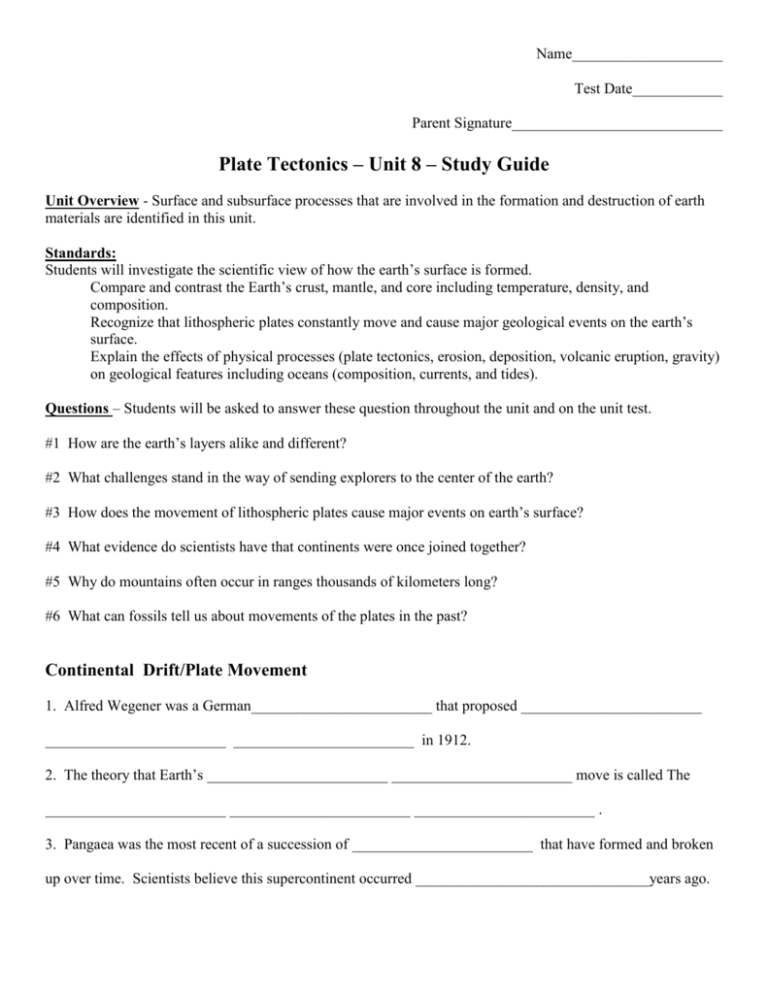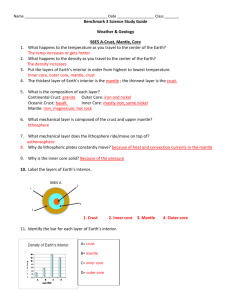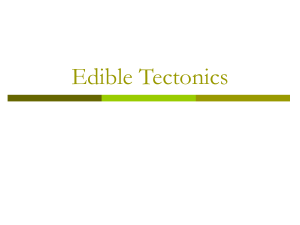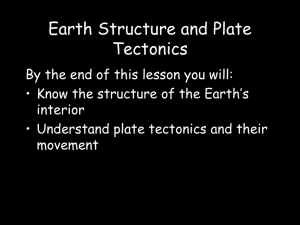Study Guide
advertisement

Name____________________ Test Date____________ Parent Signature____________________________ Plate Tectonics – Unit 8 – Study Guide Unit Overview - Surface and subsurface processes that are involved in the formation and destruction of earth materials are identified in this unit. Standards: Students will investigate the scientific view of how the earth’s surface is formed. Compare and contrast the Earth’s crust, mantle, and core including temperature, density, and composition. Recognize that lithospheric plates constantly move and cause major geological events on the earth’s surface. Explain the effects of physical processes (plate tectonics, erosion, deposition, volcanic eruption, gravity) on geological features including oceans (composition, currents, and tides). Questions – Students will be asked to answer these question throughout the unit and on the unit test. #1 How are the earth’s layers alike and different? #2 What challenges stand in the way of sending explorers to the center of the earth? #3 How does the movement of lithospheric plates cause major events on earth’s surface? #4 What evidence do scientists have that continents were once joined together? #5 Why do mountains often occur in ranges thousands of kilometers long? #6 What can fossils tell us about movements of the plates in the past? Continental Drift/Plate Movement 1. Alfred Wegener was a German________________________ that proposed ________________________ ________________________ ________________________ in 1912. 2. The theory that Earth’s ________________________ ________________________ move is called The ________________________ ________________________ ________________________ . 3. Pangaea was the most recent of a succession of ________________________ that have formed and broken up over time. Scientists believe this supercontinent occurred _______________________________years ago. 4. If a fossil is found multiple places in the world, what have scientists hypothesize might have happened a long time ago? ________________________________________________________________________________ 5. Evidence of Continental Drift 1 - ________________________ – ancient reptile found in __________________ & __________________ 2 - ________________________ - The _____________________ seem to fit together like a ___________ & same type of rock found in ________________________ and in ________________________ 3 - ________________________ – Greenland now lies in the ________________________ and is covered in ________________________ but has fossils of ________________________ 6. The Theory of Plate Tectonics is the theory that states that __________________ _____________________ is made up of _______________ _____________ that _______________ over the ______________of Earth. 7. Lithospheric plates________________________ move. 8. At the edges or ________________________ of the plates, Earth's ________________________________ 9. ________________________ ________________________ cause major ________________________ in a world map over tens of millions of ________________________. 10. Plate movement causes ________________________ such as ________________________ , ________________________ , &________________________ 11. Why do you scientists think ocean fossils are sometimes found on the tops of mountains? ______________ _________________________________________________________________________________________ 12. North American plate consists of both ________________________ and ________________________ crust. 13. The theory of plate tectonics connects the evidence for the ________________________ , ________________________ , & ________________________ of the plates. 14. Some changes in the earth’s surface are ________________________ such as earthquakes and volcanic eruptions while other changes happen ________________________such as uplift and wearing down of mountains. 15. Major geological events, such as earthquakes, volcanic eruptions, and mountain building, result from ________________________________________________________________________. Convection Currents 16. Going from the surface to the center of the earth, list the layers in order. _______________________(crust) , ________________________ (mantle), ________________________, ________________________ 17. The earth is layered with a lithosphere that contains the ________________________________________ 18. The ________________________ is the upper part of the rigid lithosphere and has a ________________________________________________under ________________________ than it does on the ________________________________________________ 19. The lithosphere is divided into ______________________________________ which ________________ very slowly in response to the convection currents in the mantle. 20. The mantle is _______________________________________________ (like hot asphalt or fudge). 21. ________________________the rigid lithosphere, the mantle consists of hot rock of tar-like consistency, which __________________________________or flows. This is also called the ________________________. 22. Convection is the __________________________________________ by the _______________________ of material. 23. Convection currents are caused by as ________________________________________________in the mantle become less dense and ________________. At the same time other molten rock cools and become more dense so they ________________________. 24. Convection currents are the ________________________________________of sinking and rising hot, soft rocks caused by ________________________________________ in the asthenosphere (mantle) of Earth 25. Heat from the ________________________ & ________________________creates convection currents. 26. Convections currents in the mantle cause the _________________________________________to move. 27. Where do convection currents take place? ________________________ 28. Less dense things ___________ while more dense things ______________ Divergent Boundaries 29. Draw pictures of the three types of boundaries: 30. Crust is destroyed at ____________________ boundaries. Crust is formed at ______________________ boundaries. Crust is neither destroyed or formed at ________________________ boundaries. 31. Divergent boundaries ________________________creating ________________________. 32. Mid-ocean ridges form at ______________ boundaries by ____________________________________. 33. Mid-ocean ridges are ________________________________________________ranges that can form at a ________________________ boundary. 34. A rift valley is _______ at divergent boundaries where molten material ____________ to build ____________________________. 35. Rift valleys can occur in the ocean to create _________________________________________ or on continents to form _______________________, ________________________, & _____________________. Convergent & Transform Boundaries 36. The two types of crust are ________________________and ________________________. Oceanic crust is ________________________than continental crust. 37. Convergent boundaries _______________________________________. 38. Subduction is the sideways and ___________________________________________ of the edge of a plate of the earth's crust into the mantle ____________________________________________. The ________________________ plate will go under the ________________________plate. 39. The three types of convergent boundaries are ___________________________ ______________________________ ___________________________ 40. When continental crust meets continental crust at a ________________________boundary, a ________________________ occurs, resulting in folds, faults, and high ________________________ 41. Ocean trench is a _______________________________________that forms when one plate goes under another at a convergent boundary. This can be __________________________________ _______________________________________. 42. At convergent boundaries oceanic plates will ________________________continental plates because oceanic crust is ________________________than continental crust. 43. Oceanic-continental convergent boundaries can form ________________________. 44. At convergent plate boundaries known as subduction zones, a ________________________ and deep earthquakes mark the zone where a ________________________________________________ descends into the mantle, and ________________________and _____________________________form on adjacent land. 45. Oceanic crust is ________________________ at an ocean ridge (________________________ boundary) and ________________________ near a trench (________________________ boundary). 46. Transform plates ________________________one another. 47. Transform boundaries ________________________other plate boundaries and are characterized by ________________________. 48. The San Andreas Fault in California is a ________________________ boundary. This is a very _____________________________________ causes ____________________________. 49. Earthquakes represent ________________________ breaks in crust continuously stressed by __________________________________________. Gradually over time, the same movements result in ________________________ crustal features. Volcanoes/Mountains 50. Only under special conditions (at hot spots and along plate boundaries) does the crust _________ to make ______________, which may then rise to the surface to make a _____________________________________. 51. The three places volcanoes form are ________________________________________________________________________ _____________________________________ ________________________ 52. List the 4 types of volcanoes. ____________________________________, ________________________, ______________________________, & _______________________________ 53. A hot spot is where heat from a plume (heated rising rocks in asthenosphere) ________________________ _________________________________________________________________________________________ 54. Hot spots can form ________________________ 55. What state was formed from a hot spot? ________________________ 56. List the two types of mountains. ___________________ Mountains, ______________________Mountains 57. Draw and describe Folded Mountains. ____________________________________________________ ________________________________________________________________________________________ ________________________________________________________________________________________ 58. Draw and describe Fault Block Mountains. ___________________________________________________ ________________________________________________________________________________________ ________________________________________________________________________________________ Vocabulary magma, fossil, subduction, Continental Drift Theory, Alfred Wegener, mid-ocean ridge, ocean trench, rift valley, hot spot, volcano, plate boundaries, convection, convection currents, fault, Theory of Plate Tectonics








